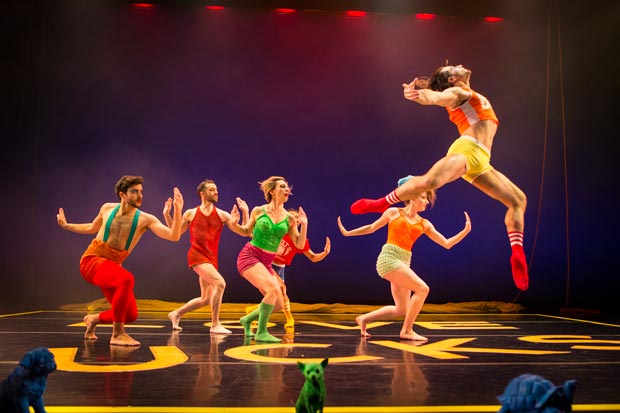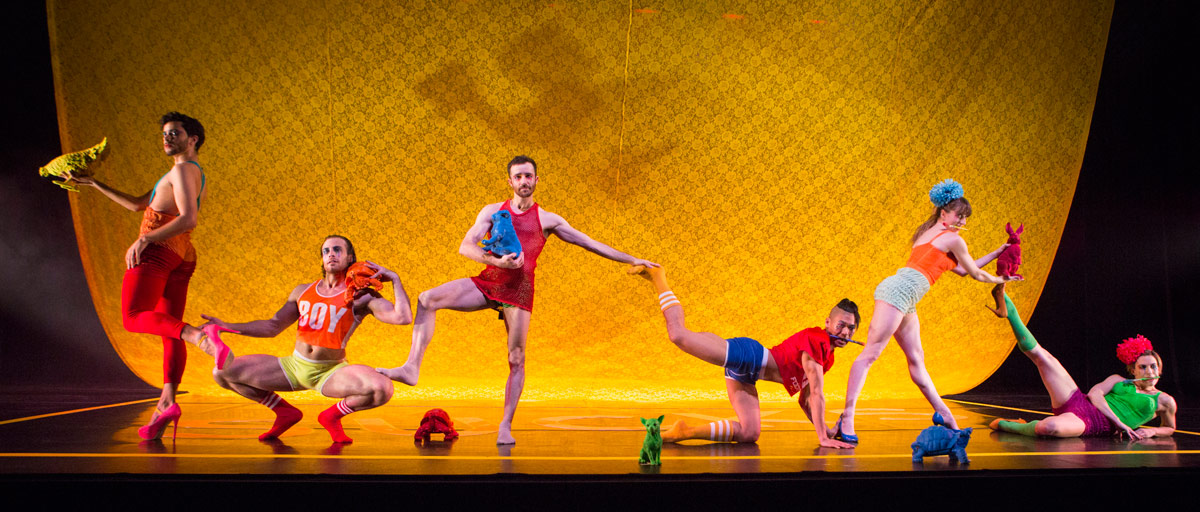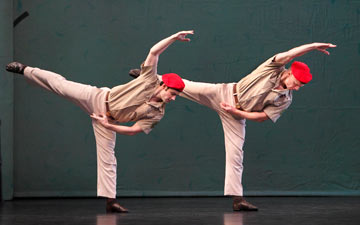
© Yi-Chun Wu. (Click image for larger version)
BODYTRAFFIC
Death Defying Dances, 3 Preludes, Private Games: Chapter One
★★✰✰✰
New York, Joyce Theater
20 January 2017
bodytraffic.com
joyce.org
BODYTRAFFIC, the Los Angeles-based contemporary dance troupe, drew a robust crowd to the Joyce on Friday night. The house was full, and the audience hungry for the eclectic program which included works by Anton Lachky, Arthur Pita and Richard Siegal.
Pita’s Death Defying Dances was the most memorable work on the bill. Set to live recordings of Judy Henske singing blues, folk and spirituals, the suite echoes earnestly in the vein of Ailey’s Revelations, in its ambition though it doesn’t nail it on the same level of aesthetic and choreographic cohesion.
Utilizing Henske’s entertaining asides and chatty preludes to songs such as “Hooka Tooka,” Death Defying Dances” regularly taps humor, despite some of the songs’ darker tones (Henske labels several “murder ballads”). Henske’s pre-song ramble to “Hooka Tooka” describes how kids used to warn bordellos prior to a raid, so adults could switch from illegal to “straight” activities, like “painting little designs on the backs of turtles,” which got her laughs from her audience. Whether or not Henske’s story is true is up for debate (the song was also recorded by Chubby Checker the same year, 1963) but it was enough to give set and costume designer, Yann Seabra, the excuse to include brightly colored plastic turtles on stage.

© Yi-Chun Wu. (Click image for larger version)
The costumes – vibrant hot pinks, greens, turquoises and yellows – seem from a Hockney color palette, with dripping, crying clown-like, technicolor eye makeup to match. Wearing bright corsets, heels and hot pants, the dancers engage in slow motion burlesque and sing along to Henske’s rounded vocals. Throughout the work a canopy of yellow lace is moved around as a backdrop, and “Love Sucks” is legible on the stage, also in yellow.
“Empty Bed Blues,” a song made famous by Bessie Smith, sees Lindsey Matheis trying to hold on to her man, who is such a good “deep sea diver” she is wary he is spreading the love farther afield. Men kitted out in deep sea diving gear come on and off the stage, which garners laughs but somehow takes away from the bawdy double entendre at the heart of the lyrics, and the entire reason for this blues ballad. A duet to the murderous tale “Love Henry” lacks choreographic dynamism and musicality, and feels more like a brief theatrical interlude than dance. A long solo by Joseph Kudra to “Danny Boy” has little contrast in feeling, for all of Kudra’s extraordinary physical effort to Henske’s emotive rendition. Musically monographic suites such as Paul Taylor’s Company B (Andrews Sisters) or Amy Seiwert’s Dear Miss Cline, (Patsy Cline), for all their superficial appearance of frivolity, actually tap deep, poignant, very human moments. While Death Defying Dances has charm, and BODYTRAFFIC’s dancers gave it their all, Pita’s efforts to tap Henske’s humanity falls short given such rich soulfulness and musical dynamics.

© Yi-Chun Wu. (Click image for larger version)
Richard Siegal’s 3 Preludes is a pleasant though innocuous work set to Gershwin. Jazzy, with hip swivels and Robbins-esque holds and pauses, the breadth of the stage feels underutilized, with much of the choreography centered on lifts. The third and final prelude is snappier than the central duet or the initial movement. Private Games: Chapter One by Anton Lachky, founder of his own Brussels-based troupe, is in his signature frenzied vein. Dancers dash around to exhaustion point, to a mixed bag of a score including Haydn, Bach and Drums of the World. Tumbling, extreme extensions, fidgeting and spastic hand and arm movements are done at rapid speed with little musical innovation. Absurdism abounds, and interludes have a woman and a man explaining to the audience his/her “games” with a person they deem their husband (danced by Guzman Rosado). At their beck and call, Rosado plays “games,” like a dog doing tricks, including snuffling like a pig. The “joke” of a simpleton character being taken advantage of via the “game” feels offensive due to its arbitrary presence as it lacks a broader narrative purpose, except to maybe point out that the real “animal” here isn’t the simpleton but the abusive parties.

















You must be logged in to post a comment.